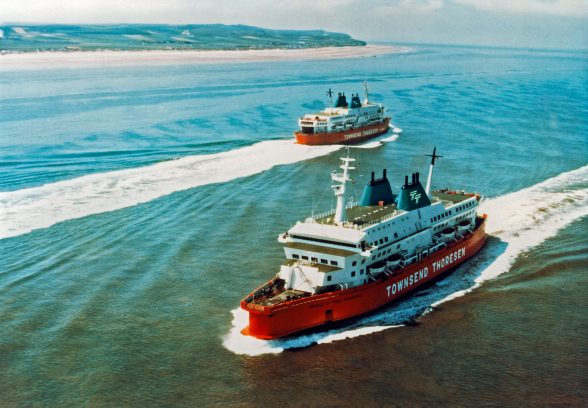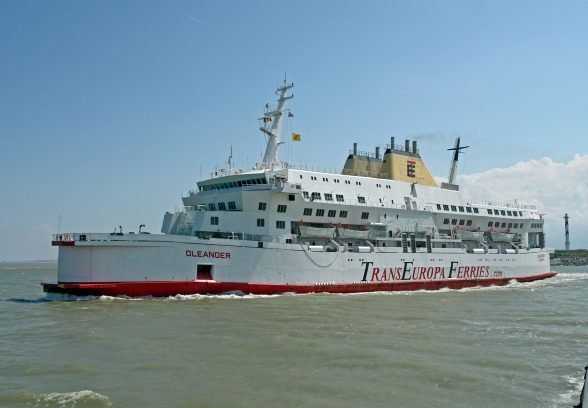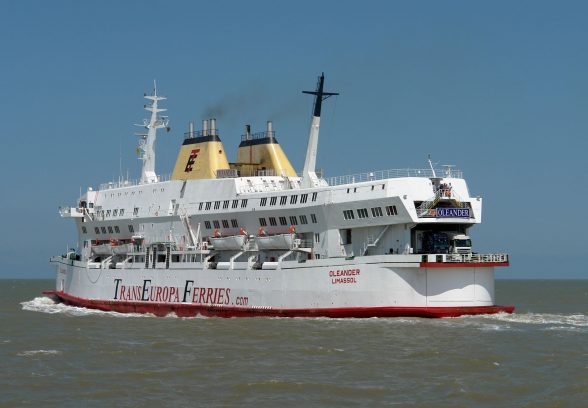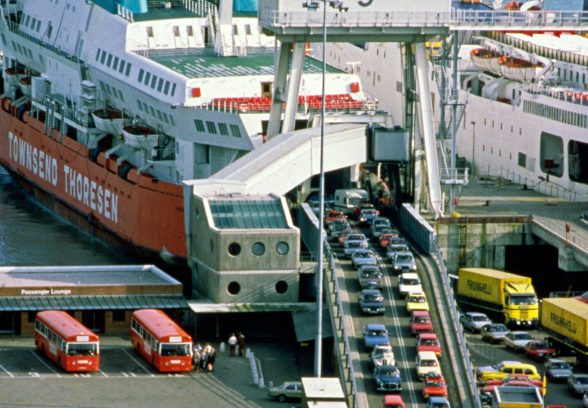This website uses cookies
This website uses cookies to enable it to function properly and to analyse how the website is used. Please click 'Close' to accept and continue using the website.






May 2010 - MS Spirit of Free Enterprise/Oleander
Naval Architect: James Ayers; Builder: Schichau Unterweser, Bremerhaven, 1980, by Bruce Peter
Modern cross-Channel ferries, which carry a large proportion of goods imported from our European neighbours, are among the most ingenious examples of contemporary naval architectural design. The Dover Strait is an extreme environment with strong lateral currents off the ports of Dover and Calais, a large tidal range, widely variable weather conditions and busy North-South shipping lanes, through which the ferries must carefully navigate. Channel ferries not only require to be very robustly constructed to survive the worst weather, but also designed to cope with evolving market conditions in what is a very competitive trade.
One of the most historically significant of these vessels is the Oleander (delivered in 1980 as Townsend Thoresen’s Spirit of Free Enterprise) and still operating on the Channel over thirty years after she was first constructed – a remarkable achievement. Back in the 1970s when she was conceived, the majority of British short-sea routes were controlled by the State railway-owned Sealink fleet, but Townsend Thoresen was an aggressive competitor whose in-house naval architect, James Ayers, brought a great deal of fresh thinking to ferry design. When Townsend Thoresen discovered that Sealink was planning to build new ferries with twin vertically-stacked vehicle decks for the Dover-Calais route, they responded immediately. Ayers was asked to design three faster and more capacious vessels, each capable of making five trips a day, to trump the Sealink fleet between Dover and Calais. A high freight capacity was vital to the business model because it was believed that firstly railway-owned hovercraft and eventually a Channel Tunnel would cream off a substantial part of the passenger market.
In designing a new generation of Dover Strait ferries for Townsend Thoresen, Ayers produced a highly original and imaginative design solution; these ships looked nothing like any others hitherto constructed. As ship design is highly regulated by national and international conventions, such radical design innovation is actually very rare indeed and most new ships only make small advances over existing designs. Ayers sought to combine a fast speed to enable typical crossings of only 75 minutes’ duration (as opposed to Sealink’s hour-and-a-half timings) with a substantial deadweight capacity for freight. As with other recent Townsend Thoresen ferries, triple-screw propulsion (three engines and propellers) was specified, a trio of Sulzer diesels providing a 24-knot service speed. This allowed substantial excess power to make up for any delays. Each vessel had capacity for 1,300 passengers and 350 cars.
To enhance stability, the centre of gravity was kept low, partly by reducing the distance from the waterline to the lower vehicle deck amidships and partly by narrowing the superstructure and stowing the lifeboats in recesses on either side of the upper vehicle deck. This arrangement was also theoretically safer as there was only three decks’ drop to the water and so aircraft-style chutes could be used to speed up evacuation.
As the Dover Strait has a large tidal range, the sides of all existing ferries sloped inwards from the waterline upwards to prevent their superstructures from fouling shore facilities as, when tied up with a rising tide, they heeled over towards the quay. On the new design, this slope began at mezzanine deck height, half-way up the hull topsides, meaning that there was a pronounced fold along the length of the hull. Above the upper vehicle deck, the superstructure widened out to maximise the saloon deck area, then narrowed again for the officers’ accommodation on the topmost decks. This entirely practical design gave the ferries a uniquely dynamic and sculptural appearance, which was enhanced by chunkily-proportioned masts and twin funnels. Another innovation was the design of the bow and stern doors which opened out and sideways without protruding beyond the belting (protective rubbing stake around the hull). This offered both safety and operational enhancements as, unlike ferries with lifting visors, there would be neither upward wave pressure nor the risk of damage during berthing procedures due to the belting’s protection. The overall design appeared to have an aesthetic relationship with constructivist architecture of the immediately preceding era on terra firma, but was unprecedented in the annals of ship design. Ayers considered it important that Townsend Thoresen’s ferries should appear as different as possible from those of Sealink in terms of form and livery – something he certainly achieved. Furthermore, he emphasises that he cared little for naval architecture’s ‘traditional’ aesthetic conventions; a modern ferry should not be constrained by the need to conform to styling principles inherited from the past.
Townsend Thoresen were fortunate that their builder, Schichau Unterweser in Bremerhaven, was able to construct each ferry in only a year, meaning that the first, named the Spirit of Free Enterprise, was completed in January 1980, nine months ahead of Sealink’s initial new ship, the St Anselm from Harland & Wolff in Belfast. She was, therefore, the first passenger-carrying ferry on the Dover Strait with two vehicle decks and double-level loading and she set the tone of all subsequent developments on the route. Having claimed the record for the fastest Dover-Calais crossing by conventional ferry, Townsend Thoresen marketed the route as their ‘Blue Riband Service.’ The Herald of Free Enterprise and the Pride of Free Enterprise followed shortly thereafter.
From then on, the three ‘Spirit’ class ferries proved highly successful; coming out of Calais at full speed, they made a powerful impression in their bright orange, white and turquoise livery. Most unfortunately, on the evening of 6th March 1987, the Herald of Free Enterprise – which was temporarily deputising on the Dover-Zeebrugge service – left her berth in Zeebrugge with her bow doors open and headed out to sea. As there was a high tide, she was trimmed downwards at the bow and, when her speed increased, she began to scoop up increasing quantities of water into her lower vehicle deck. Just under half an hour from departure, she became critically unstable and capsized, ending up partially submerged, her starboard side resting on a sandbank. Of the 573 passengers onboard that evening, 193 drowned, as the ferry sank too quickly for her life saving appliances to be used.
Twenty-three years after the Herald of Free Enterprise disaster, the former Spirit of Free Enterprise remains in operation across the Channel between Ramsgate and Oostende as TransEuropa Ferries’ Oleander. With the benefit of hindsight, it is possible to conclude that her original design was remarkably prescient. She remains in pristine condition externally (although her passenger accommodation has been substantially rebuilt over the years). She is still a very distinctive-looking ferry but also of remarkably up-to-date appearance, considering her great age – for a ship, at least.
Bruce Peter lectures in design history at The Glasgow School of Art. Being half-Danish – and, therefore, a regular traveller across the North Sea – he has a life-long fascination with modern merchant ships of all kinds (nowadays, Denmark has the world’s leading merchant fleet). His wider interests relate to the design and sociology of modern transport and leisure environments and their possible relationship with the Modern Movement in architecture and design. At present, he is collaborating with the maritime historian Philip Dawson to complete a new book, entitled ‘The Ferry: A Drive-Through History’ for publication in November 2010. He is a graduate of The Glasgow School of Art, the Royal College of Art and the University of Glasgow.
Look for past Buildings of the Month by entering the name of an individual building or architect or browsing the drop down list.

Become a C20 member today and help save our modern design heritage.